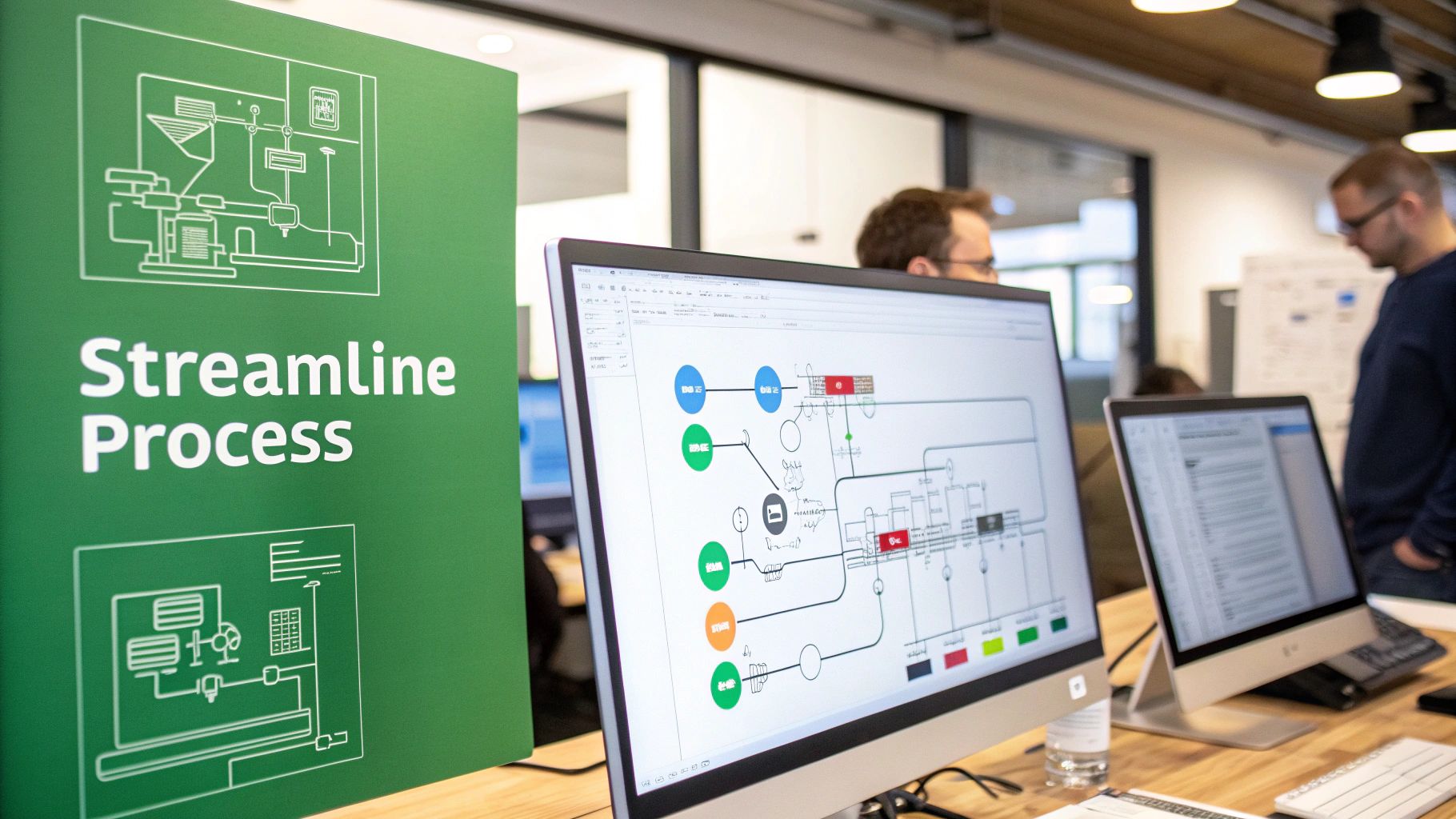Why Faster Development Matters Now More Than Ever

In the competitive tech industry, speed is essential. Businesses need to consistently release new features and products to stay ahead. This puts immense pressure on software development teams to accelerate their development cycles. But simply rushing can lead to costly mistakes and impact quality.
So, how can teams develop software faster without compromising quality? The solution lies in strategic planning, optimized processes, and the right tools.
Optimizing Your Development Process
Integrating automation into key workflows, for example, significantly reduces manual work and streamlines repetitive tasks. This frees up developers to focus on more important things, like solving problems and innovating.
One key metric to track is cycle time. This measures the time it takes to complete a development task. A long cycle time often indicates underlying problems. These could include inefficient processes, inadequate tools, or high technical debt.
By tracking and analyzing cycle time, teams can identify bottlenecks and optimize their workflows. For instance, if large pull requests are slowing things down, automating parts of the code review process can help. Learn more about optimizing development cycles with resources from LinearB.
The Benefits of Speed
Faster development cycles lead to a quicker time-to-market. This allows businesses to seize new opportunities and adapt to changing market demands. Faster iteration also means more frequent feedback, resulting in products that truly meet user needs.
This iterative approach also minimizes risk. Potential problems are identified and addressed early in the development lifecycle. In the end, speed combined with quality becomes a significant competitive advantage.
Leveraging AI To Supercharge Your Development Process

Speed is essential in software development. Integrating artificial intelligence (AI) offers exciting possibilities for accelerating the development process. AI is changing how teams write, test, and debug code, leading to significant improvements in efficiency. This section explores how AI tools impact the entire software development lifecycle.
AI-Powered Coding Assistants
One of the most prominent applications of AI in software development is through coding assistants. These tools leverage machine learning to provide code suggestions, auto-completions, and even generate entire code blocks. This helps developers write code faster and with fewer errors.
Additionally, AI can analyze code for potential bugs and security vulnerabilities, catching issues early in the development process. This means developers can spend less time on tedious tasks and more time on complex problem-solving and innovation.
Furthermore, AI can assist with code refactoring, simplifying the process of maintaining and updating codebases. This contributes directly to a more efficient and sustainable development process. The introduction of generative AI coding assistants has markedly improved software development efficiency.
Companies using these tools typically see efficiency improvements of about 10% to 15% on average. However, organizations adopting a more comprehensive approach, including generative AI beyond code generation, can achieve gains of 30% or more. For instance, Intuit’s adoption of generative AI across its development platform led to significant improvements in velocity and task completion times. For more detailed statistics, check out this report from Bain & Company.
Beyond Code Generation: AI Across The Development Lifecycle
AI’s role extends beyond just writing code. It’s proving valuable in other areas of the development lifecycle, including:
- Testing: AI can automate test case generation and execution, leading to faster and more thorough testing processes.
- Bug Identification: AI algorithms can analyze code to identify potential bugs and vulnerabilities, often before they cause significant issues.
- Optimization: AI can analyze performance data to suggest optimizations for code and infrastructure. These expanded AI applications are transforming how teams approach software development. This results in faster delivery times and higher-quality products. By automating time-consuming tasks, AI frees up developers to focus on strategic decision-making and true innovation.
The following table summarizes the efficiency gains and best use cases for different AI tools:
AI Tool Efficiency Comparison: Comparison of different AI-powered development tools and their impact on development speed
As shown in the table, while basic code generation tools can provide a decent efficiency boost, adopting broader AI solutions across testing, bug identification, and optimization can significantly increase development speed and improve overall software quality.
Choosing The Right AI Tools
Selecting the right AI tools is crucial for maximizing their benefits. Factors to consider include:
- Project Requirements: Different AI tools specialize in different areas, such as code generation, testing, or security analysis. Choose tools that align with your project’s specific needs.
- Team Composition: The chosen tool should be user-friendly and integrate seamlessly into the team’s existing workflow. Consider your team’s technical skills and experience when selecting a tool.
- Implementation Challenges: Be prepared to address potential integration challenges and provide adequate training to your team. A smooth implementation process is crucial for maximizing the tool’s effectiveness. By carefully evaluating these factors, teams can choose AI tools that truly supercharge their development process and contribute to faster, more efficient software development.
Building Deployment Pipelines That Actually Deliver

Your deployment pipeline can have a major impact on how quickly your team develops software. This section explores how high-performing engineering teams leverage CI/CD best practices to decrease their time-to-market without impacting quality. We’ll see how automating strategically can turn slow, cumbersome deployments into a real competitive edge.
The Power of Automation
Automating your deployment pipeline is essential for faster software development. This involves automating repetitive tasks like building code, running tests, and deploying the software to various environments. By automating these processes, developers can dedicate their time to writing code.
This automation also minimizes the risk of human error. The result is more reliable and consistent deployments.
Imagine a scenario where every single code change requires manual testing and deployment. This process is slow, error-prone, and ultimately frustrating for developers. An automated pipeline, on the other hand, allows these same steps to be completed quickly, reliably, and with minimal human involvement. This increased efficiency is invaluable in today’s demanding development landscape.
Key CI/CD Practices for Faster Development
Here are a few CI/CD practices that can drastically improve development speed:
- Containerization: Using containers like Docker helps create consistent environments across development, testing, and production. This simplifies deployments and reduces those pesky compatibility issues, leading to faster and more predictable releases.
- Infrastructure as Code (IaC): IaC automates the provisioning and management of your infrastructure. This removes manual configuration and makes sure environments are consistent. The benefits? Faster deployments and a reduced risk of errors stemming from inconsistencies.
- Automated Testing: Automated tests at every stage of the pipeline ensure that code changes are thoroughly vetted before deployment. This lowers the chance of bugs making it to production and allows for faster, more confident releases. These practices, when implemented properly, work together to build a streamlined and efficient deployment pipeline. The outcome: faster releases and noticeably higher-quality software.
Measuring Deployment Frequency and Its Impact
Deployment frequency—a metric tracking how often code is deployed to different environments—is tightly connected to a team’s Agile maturity. Frequent deployments are a key characteristic of continuous development, allowing teams to respond quickly to customer needs and keep delays to a minimum. Deployment frequency measures how often code lands in staging, testing, or production environments. This metric is directly related to Agile maturity, as frequent deployments are a major component of continuous development. By increasing deployment frequency, teams can respond more quickly to customer needs and shorten delays.
It’s important to consider the size of deployments when tracking this metric. Smaller changes facilitate more frequent deployments and simpler identification of errors. High deployment frequency is also linked to better risk management and quicker recovery times should any problems arise. Learn more with these insights about software development KPIs.
Furthermore, focusing on smaller deployments is generally a good practice. Smaller changes make deployments more frequent and simplify troubleshooting if something goes wrong. This ability to quickly pinpoint and fix issues is key for maintaining a fast development pace. This refined process significantly contributes to improving overall software development speed.
Unleashing Your Developers’ True Productive Potential

This section explores how to cultivate a work environment where developers can achieve peak productivity. We’ll delve into strategies, tools, and workflow optimizations that empower developers to perform at their best. This involves understanding how successful organizations create environments where deep, focused work can flourish.
Creating a Productivity-Boosting Environment
Eliminating distractions is paramount for developer productivity. Unnecessary meetings, constant interruptions, and a lack of focused work time can significantly impede progress. Establishing dedicated “focus time” and minimizing distractions are critical.
This can involve strategies like scheduling specific blocks of time for concentrated work, using noise-canceling headphones, or implementing communication protocols that minimize disruptions.
Providing developers with the right tools and resources is also essential. This extends beyond the software they use for coding, encompassing everything from ergonomic workspaces and efficient hardware to access to relevant learning materials.
Furthermore, a culture of collaboration and knowledge sharing can dramatically boost productivity. Creating opportunities for developers to learn from each other and share best practices can help eliminate redundant work and facilitate faster problem-solving. This fosters a positive feedback loop, continuously enhancing the team’s overall effectiveness.
Identifying and Addressing Bottlenecks
Identifying and removing roadblocks is another crucial aspect of maximizing developer productivity. Common bottlenecks include technical debt, cumbersome approval processes, and unclear communication channels.
These obstacles can lead to frustration and slow down the entire development lifecycle. A streamlined code review process, for instance, can prevent delays and keep projects on track. Leading tech companies recognize this and aim for developers to spend up to 70% of their time on inner-loop activities like coding and unit testing.
These activities directly contribute to product development. Outer-loop activities, such as integration and deployment, while necessary, are often less engaging for developers. Automating these outer-loop tasks, like infrastructure provisioning and test data management, allows developers to focus on value-added work, boosting both productivity and job satisfaction. Learn more about measuring developer productivity here.
Measuring Meaningful Metrics
Simply tracking lines of code written is a superficial approach to measuring developer impact. More insightful metrics include the number of features shipped, bug resolution rates, and cycle time.
These metrics offer a more accurate assessment of developer performance and overall team effectiveness. This shift in focus allows teams to monitor progress more effectively and pinpoint areas for improvement.
Balancing focused development time with essential collaboration is also key. While deep work is fundamental, effective teamwork and communication are equally vital for project success. This necessitates strategies that support both individual focus and collaborative problem-solving. You might find this helpful: How to master automated testing best practices. By addressing these crucial areas, organizations can build an environment that truly empowers developers and accelerates the software development process.
Making Agile Actually Work For Acceleration
Many teams say they’re Agile, but their practices don’t actually speed up development. This section contrasts ineffective Agile implementations with those that deliver measurable improvements, offering practical techniques for adapting Agile to your specific team and project.
Right-Sizing Agile Ceremonies
Traditional Agile ceremonies can become bloated and time-consuming, hindering rather than helping development speed. High-performing Agile teams “right-size” their ceremonies. This means adapting their length and frequency to the team’s actual needs. For example, instead of hour-long daily stand-ups, some teams hold shorter, more focused check-ins.
This keeps everyone informed without derailing their workflow. Similarly, sprint planning meetings should be efficient and focused on clear goals and well-defined tasks. This contributes to a smoother sprint and prevents unnecessary back-and-forth.
Additionally, retrospectives can be powerful tools for continuous improvement. However, to maximize their impact, they should be action-oriented. Identify concrete steps for improvement and assign ownership for implementing those changes. This ensures retrospectives drive real change, not just discussion.
Optimizing Sprint Planning for Speed
Effective sprint planning is fundamental to accelerating Agile development. Accurately estimating the effort required for each task and avoiding overcommitting is crucial. This prevents sprints from becoming overloaded and ensures a realistic workload for the team.
Breaking down large tasks into smaller, more manageable units is another crucial aspect. This simplifies effort estimation and allows for more frequent progress tracking. It also helps identify potential roadblocks more quickly. These smaller tasks also foster a sense of accomplishment and maintain team momentum.
Furthermore, prioritizing tasks based on their business value ensures that the most important features are delivered first. This maximizes the impact of each sprint and contributes to a more effective development process overall.
Measuring the Impact of Agile Practices
It’s important to measure the real impact of your Agile practices on development velocity. Track metrics such as sprint completion rate, cycle time, and lead time. These offer quantifiable insights into how your processes are impacting development speed.
To understand how your Agile implementation is performing, review the following key performance indicators (KPIs). The table below outlines important metrics, expected improvements, potential warning signs, and measurement methods.
Agile Implementation Success Metrics: Key performance indicators that show if your Agile implementation is actually speeding up development.
By monitoring these KPIs, teams can identify areas for improvement and refine their Agile approach to maximize its impact on development speed. Consistent tracking provides valuable data for informed decision-making and process adjustments. It’s an ongoing process of adaptation and refinement, ensuring that Agile remains a tool for true acceleration, not just a buzzword. Honest discussions about common pitfalls and proven avoidance strategies—while maintaining quality—are essential for long-term success.
Your Roadmap to Faster Software Development
This section provides a practical guide to speeding up your software development process. We’ll cover quick wins and long-term strategies, complete with clear steps for implementation. We’ll also explore how successful organizations track progress beyond basic velocity metrics and maintain momentum during the transition.
Prioritizing Strategies for Different Team Sizes
Different acceleration strategies suit different team structures and sizes. A small startup’s approach will differ significantly from that of a large enterprise. Here’s a prioritized checklist for various team sizes:
- Startups: Early-stage companies should concentrate on rapid iteration and quick feedback. Continuous Integration and Continuous Delivery (CI/CD) using tools like Jenkins is essential. Automating testing and deployments early establishes a strong foundation for future growth. Streamlined communication is also vital in this fast-paced setting. Learn more about accelerating development velocity in our article: accelerating software development velocity.
- Mid-Sized Teams: As teams expand, it becomes crucial to balance speed with maintainability. Robust code review processes, addressing technical debt, and investing in helpful developer tools like GitHub become increasingly important. Standardized workflows and clear documentation improve communication and reduce friction as the team scales.
- Enterprise Organizations: Large organizations should prioritize scalability and coordination across multiple teams. Implementing consistent development practices, breaking down silos, and investing in tools that support large-scale collaboration, such as Jira, are key. A clear technology roadmap and continuous training ensure everyone stays aligned.
Measuring Progress Beyond Velocity
While velocity is a helpful metric, it doesn’t provide a complete picture. Successful organizations track a broader range of factors, including:
- Cycle Time: This measures the time it takes to complete a task, from initial idea to implementation. Reducing cycle time directly translates to faster development.
- Lead Time: This tracks the time it takes to deliver a feature to the customer, from request to deployment. Shorter lead times signify faster value delivery.
- Deployment Frequency: This indicates how often your team deploys working software. Higher deployment frequency suggests a more efficient development process.
- Defect Rate: This measures the number of bugs introduced during development. A lower defect rate contributes to faster, higher-quality development cycles. Monitoring these metrics provides a comprehensive understanding of your team’s performance and helps identify areas for improvement.
Maintaining Momentum and Adapting to Change
Transforming development practices requires ongoing effort and adaptation. To maintain momentum, establish clear communication channels and ensure team-wide alignment on goals and strategies. Regular retrospectives provide opportunities for reflection and adjustment. This iterative approach promotes continuous improvement and prevents stagnation.